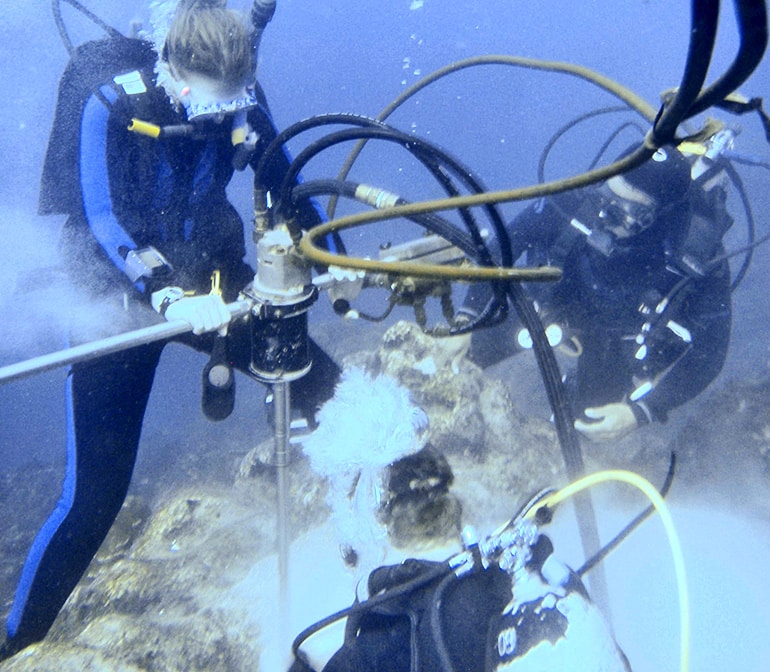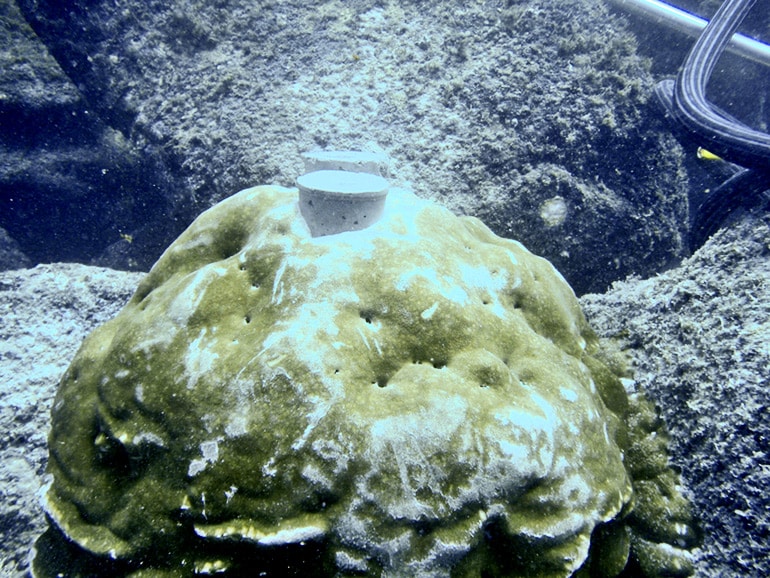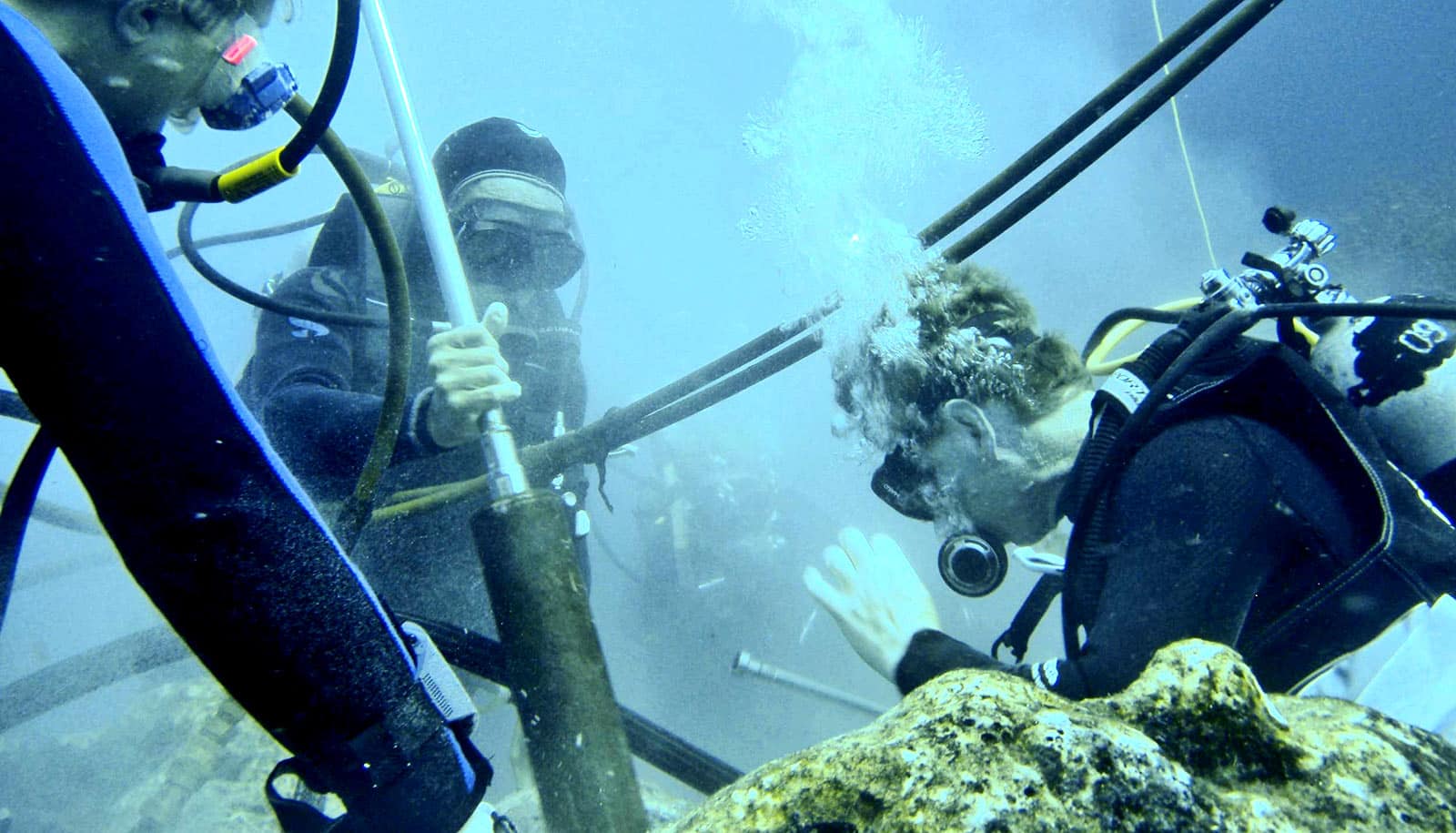The ocean around the Galápagos Islands has been warming since the 1970s, according to new research.
The finding surprised the research team, because the sparse instrumental records for sea surface temperature for that part of the eastern tropical Pacific Ocean did not show warming.
“People didn’t know that the Galápagos or eastern Pacific was warming. People theorized or suggested it was cooling,” says lead author Gloria Jimenez, a doctoral candidate in geosciences at the University of Arizona who completed the research as part of her doctoral work.
Scientists thought strong upwelling of colder deep waters spared the region from the warming seen in other parts of the Pacific, she says.

Jimenez studied cores taken from coral heads in the uninhabited northern part of Ecuador’s Galápagos National Park. The cores represented the years 1940 to 2010. Corals lay down seasonal growth layers that serve as a natural archive of ocean temperatures.
Her analysis revealed that from 1979 to 2010, regional ocean temperatures increased almost 0.4 degrees F (0.2 degrees C) per decade—about 1.1 degrees F (0.6 degrees C) overall.
The very strong El Niño of 1982-1983 temporarily warmed the surrounding ocean so much that most of the corals in the southern part of the Galápagos died, said coauthor Julia Cole, who collected the coral cores while she was a faculty member at UA.
‘Particularly disturbing’
Cole is concerned about ocean warming around the northern Galápagos and parts of the eastern tropical Pacific.
“Warming in this area is particularly disturbing, because it’s the only place that reefs have persisted in the Galápagos. This suggests those reefs are more vulnerable than we thought,” says Cole, now a professor of Earth and environmental sciences at the University of Michigan.
For 30 years, Cole, a paleoclimatologist, has been studying climate change and the El Niño/La Niña climate cycle.
“Losing the corals would be an enormous blow to the underwater biodiversity.”
In 1989, she went to the Galápagos hoping to use the natural climate archives stored in corals to develop a long-term record of El Niño, but found that none of the large, old corals others reported had survived the intense warming of the 1982-1983 El Niño.
“We went from site to site—and they were all gone,” Cole says. “One of my coworkers said, ‘There used to be corals here, and now all I see is sand.'”
Years later, she heard large corals were still alive near Wolf Island in the remote northern part of the Galápagos archipelago, so, in 2010, she followed up on the tip with a team that included coauthors Tudhope and Thompson, then a geosciences graduate student at the University of Arizona.
The team members dived to the reef and took several cores from large, blobby dome-shaped Porites lobata corals using an underwater hydraulic drill powered by vegetable oil. The 3 1/2-inch (8.9 cm) diameter cores ranged from 2 to 3 feet long and had annual bands 0.4 to 0.8 inch (1-2 cm) wide. Each core showed damage from when the coral stopped growing during the 1982-1983 El Niño and then started growing again.

Jimenez used chemical analysis to tease temperature information out of two of those coral cores.
Coral skeletons are made mostly of calcium carbonate. However, corals sometimes substitute the element strontium for the calcium. Corals substitute more strontium when the water is cold and less when the water is warm, so the strontium/calcium ratio of a bit of skeleton can reveal what the water temperature was when that piece of skeleton formed.
Charting changes in the Galápagos
Jimenez used a little drill bit to take a tiny sample every millimeter for the length of each core. She took 10 to 20 samples from each annual band of each core and analyzed the samples for the strontium/calcium ratio using atomic emission spectrometry.
Climate change won’t stop stony corals from making rock
She then used that information to create a continuous record of the region’s ocean temperature from 1940 to 2010.
Because the El Niño/La Niña climate cycle generates large fluctuations in ocean temperatures around the Galápagos and in the eastern tropical Pacific, long-term changes can be hard to spot.
Jimenez wanted to determine whether the region’s ocean temperature changed significantly from 1940 to 2010. So, she analyzed her Galápagos coral temperature chronologies alongside published coral temperature chronologies from islands farther north and west and instrumental sea surface temperature records from the southern Galápagos town of Puerto Ayora and the Peruvian coastal town of Puerto Chicama.
Jimenez says her research convinces her that the ocean around the Galápagos and much of the eastern tropical Pacific is warming. She is concerned about the effect of warming seas.
“The Galápagos National Park has been designated a World Heritage Site because it’s a special and unique place,” Jimenez says. “Losing the corals would be an enormous blow to the underwater biodiversity.”
Iron ‘pulses’ in the Pacific may have slowed climate change
Jimenez’s next project involves analyzing an 8-foot-long Galápagos coral core she collected in 2015 that goes back to about 1850.
The research paper by Jimenez, Cole, and coauthors from Boston University and the University of Edinburgh appears in Geophysical Research Letters.
The National Science Foundation, the UK Natural Environment Research Council, and the Philanthropic Education Organization Fellowship funded the research.
Source: University of Arizona and University of Michigan



